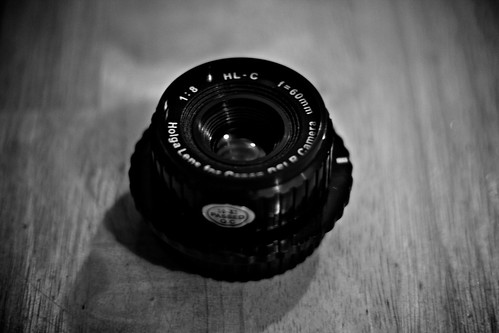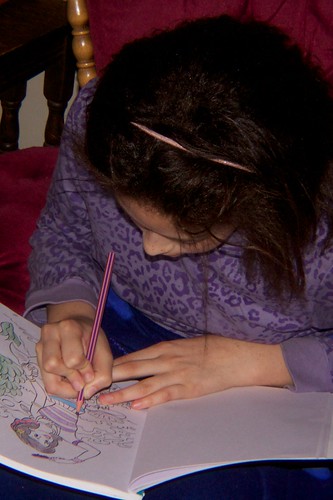I picked up this silly bit of kit from Four Corner Store, a stockist of toy cameras from years gone by, for no particularly good reason. It just seemed like a laugh. It's the 60mm, f/8 fixed aperture lens from a Holga plastic camera.
The lens itself is entirely plastic. Even the "glass" is clear plastic. Focussing is achieved by turning the front plastic bit and a plastic thread turns and moves another plastic bit. It's very, very tacky and I must be careful not to just rip it apart by accident.
It's an anachronistic thing. Designed for 120 film with its 56mm square sensor size, using it on an APS-C digital sensor loses many of the characteristic effects. For example, the strong vignetting of Holga images is simply not present because the bit that would be vignetted is cropped away by the much smaller imaging area. It does feel really rather strange to be manipulating a 25MB, 15 megapixel RAW image shot through a piece of plastic.
A typical sunny daylight image might look something like this:
Only a tiny amount of vignetting, barely visible if at all, and actually a pretty clear and sharp image. Well, the bits more than 1 metre away are, which appears to be the lens's minimum focussing distance.
To make it feel more "old fashioned" you can, of course, mess with post-processing effects. Like fake cross-processing:
Or maybe a spot of "toy camera" preset, with very heavy vignetting and boosted saturation:
How about going a little 70s retro and fading it out?
It's surprising how sharp the images from such a strange little thing can be. Consider this, taken indoors with flash:
Pretty decent, actually. Especially if you pixel-peep and have a look at the 100% crop.
I'd go so far as to say that the image is far better than any compact sensor produces. Which is bonkers. Maybe the producers of bridge or superzoom cameras need to spend less time faffing with optics and more time getting their sensors to not suck?
The lens itself is entirely plastic. Even the "glass" is clear plastic. Focussing is achieved by turning the front plastic bit and a plastic thread turns and moves another plastic bit. It's very, very tacky and I must be careful not to just rip it apart by accident.
It's an anachronistic thing. Designed for 120 film with its 56mm square sensor size, using it on an APS-C digital sensor loses many of the characteristic effects. For example, the strong vignetting of Holga images is simply not present because the bit that would be vignetted is cropped away by the much smaller imaging area. It does feel really rather strange to be manipulating a 25MB, 15 megapixel RAW image shot through a piece of plastic.
A typical sunny daylight image might look something like this:
Only a tiny amount of vignetting, barely visible if at all, and actually a pretty clear and sharp image. Well, the bits more than 1 metre away are, which appears to be the lens's minimum focussing distance.
To make it feel more "old fashioned" you can, of course, mess with post-processing effects. Like fake cross-processing:
Or maybe a spot of "toy camera" preset, with very heavy vignetting and boosted saturation:
How about going a little 70s retro and fading it out?
It's surprising how sharp the images from such a strange little thing can be. Consider this, taken indoors with flash:
Pretty decent, actually. Especially if you pixel-peep and have a look at the 100% crop.
I'd go so far as to say that the image is far better than any compact sensor produces. Which is bonkers. Maybe the producers of bridge or superzoom cameras need to spend less time faffing with optics and more time getting their sensors to not suck?







Comments
Post a Comment